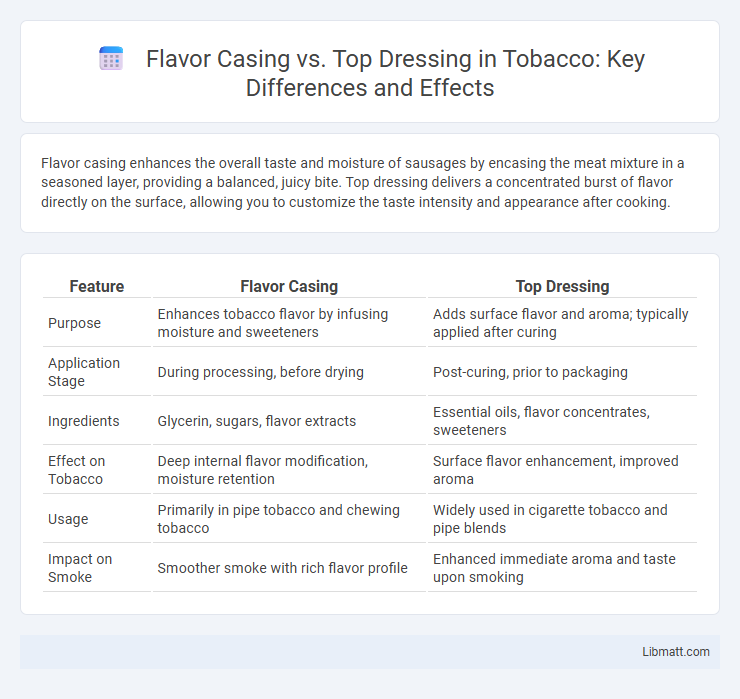Flavor casing enhances the overall taste and moisture of sausages by encasing the meat mixture in a seasoned layer, providing a balanced, juicy bite. Top dressing delivers a concentrated burst of flavor directly on the surface, allowing you to customize the taste intensity and appearance after cooking.
Table of Comparison
| Feature | Flavor Casing | Top Dressing |
|---|---|---|
| Purpose | Enhances tobacco flavor by infusing moisture and sweeteners | Adds surface flavor and aroma; typically applied after curing |
| Application Stage | During processing, before drying | Post-curing, prior to packaging |
| Ingredients | Glycerin, sugars, flavor extracts | Essential oils, flavor concentrates, sweeteners |
| Effect on Tobacco | Deep internal flavor modification, moisture retention | Surface flavor enhancement, improved aroma |
| Usage | Primarily in pipe tobacco and chewing tobacco | Widely used in cigarette tobacco and pipe blends |
| Impact on Smoke | Smoother smoke with rich flavor profile | Enhanced immediate aroma and taste upon smoking |
Introduction to Flavor Casing and Top Dressing
Flavor casing is a specialized mixture used primarily in meat processing to enhance taste, texture, and moisture retention, consisting of spices, emulsifiers, and binders that form a seasoned coating. Top dressing involves the application of dry or liquid seasoning blends directly onto food surfaces, commonly used in baking and snack production to add flavor and visual appeal. Both techniques serve distinct purposes in flavor enhancement, with flavor casing providing an internal seasoning layer and top dressing offering an external flavor boost.
Defining Flavor Casing in Tobacco Production
Flavor casing in tobacco production involves applying a liquid or syrup-based mixture containing sweeteners, humectants, and flavor additives directly to tobacco leaves to enhance aroma and taste. Unlike top dressing, which is a surface application of flavoring agents primarily for immediate sensory impact, flavor casing penetrates the leaf to modify the tobacco's intrinsic properties and improve burn qualities. This process is critical for tailoring the final product's flavor profile and ensuring consistent quality in cigarette and cigar manufacturing.
What is Top Dressing?
Top dressing involves applying a thin layer of soil, compost, or organic material over turf or garden beds to improve soil quality, moisture retention, and nutrient availability. It enhances grass growth by smoothing the surface, promoting root development, and reducing thatch accumulation. Unlike flavor casing, which is often used in mushroom cultivation for moisture control, top dressing is primarily a horticultural technique for maintaining healthy landscapes and gardens.
Key Differences Between Flavor Casing and Top Dressing
Flavor casing involves applying a seasoned or flavored solution directly onto food before cooking or smoking to enhance moisture retention and infuse deep, consistent taste. Top dressing is a finishing touch where a flavored or textured layer is added after cooking, providing a burst of flavor and visual appeal without altering the underlying dish's moisture content. Understanding these differences helps you choose the right technique to maximize flavor impact and presentation in your culinary creations.
Common Ingredients Used in Flavor Casing
Flavor casing typically includes a combination of water, fats, sugars, and seasonings such as smoke powders, liquid smoke, and spices that penetrate meat products for enhanced flavor and moisture retention. Top dressing consists mainly of dry spices, salt, sugar, and flavor enhancers like MSG, which adhere to the surface of meat or snack products to provide a burst of immediate flavor. Both methods rely on carefully balanced ingredients to complement the product's texture and intended taste profile.
Popular Top Dressing Techniques and Components
Popular top dressing techniques include the application of fine layers of compost, sand, or organic matter to enhance turfgrass health and soil quality. Common components used in top dressing are compost, sand, peat moss, and soil amendments, which improve soil aeration, nutrient content, and moisture retention. These techniques promote smoother playing surfaces and encourage deeper root growth compared to flavor casing, which primarily focuses on flavor enhancement in food products.
Flavor Impact: Casing vs Top Dressing
Flavor casing delivers a uniform and intense flavor infusion by surrounding the product with a flavored coating, allowing for deep absorption and prolonged taste release. Top dressing provides a more immediate and surface-level flavor impact, enhancing initial taste perception without significantly penetrating the product interior. Choosing casing results in a richer, more integrated flavor experience, while top dressing emphasizes freshness and visual appeal with a lighter flavor overlay.
Application Methods: When and How They're Used
Flavor casing is typically applied during the production process by tumbling or injecting into sausages to infuse consistent taste throughout, enhancing internal flavor profiles. Top dressing involves sprinkling or brushing spices, herbs, or flavor blends onto the surface of cooked or grilled meats as a finishing touch to create a bold, immediate taste impact. Both methods are used strategically to achieve distinct flavor intensities and profiles depending on the desired culinary outcome.
Industry Insights: Preferences and Trends
Flavor casing and top dressing represent two popular techniques in the food industry, each influencing product appeal through texture and taste enhancement. Recent industry insights show a growing preference for flavor casings in meat products due to their ability to uniformly infuse spices and maintain moisture, enhancing overall flavor profiles. Your choice between flavor casing and top dressing should consider consumer trends favoring natural and intense tastes, with casings leading in processed meats and top dressings preferred for customizable, visible seasoning layers.
Conclusion: Choosing Between Flavor Casing and Top Dressing
Flavor casing enhances the core taste and aroma by encapsulating ingredients, ensuring consistent flavor delivery throughout the product, whereas top dressing provides a more immediate and visually impactful burst of flavor on the surface. Selecting between flavor casing and top dressing depends on whether the desired effect is uniform flavor integration or a prominent, fresh flavor accent. Manufacturers prioritize flavor casing for long-lasting taste enhancement and top dressing for immediate flavor appeal and texture contrast.
Flavor casing vs Top dressing Infographic

 libmatt.com
libmatt.com